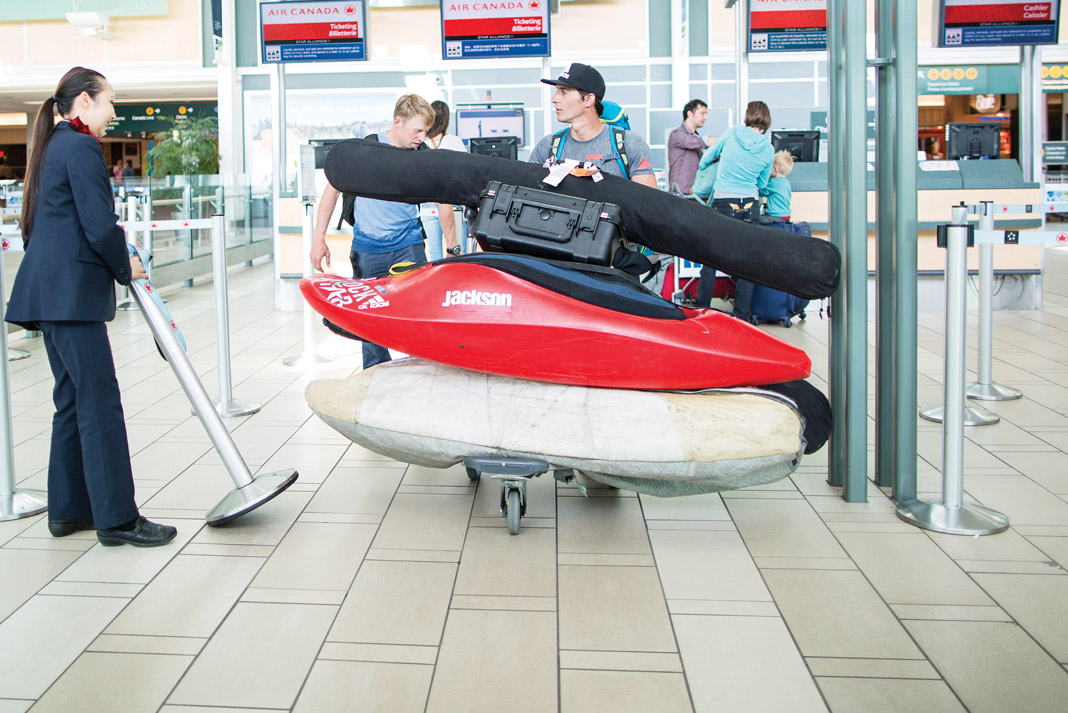There’s no doubt that figuring out how to fly with a kayak can be a pain. Kayaks are big, bulky and prohibited on many airlines. Yet, kayakers willing to jump through some administrative hoops and play by the airline rules will likely be rewarded for their efforts.
3 steps to fly hassle-free with a kayak
1 Do your own research
Research which airlines allow you to fly with a kayak. Some airlines won’t take kayaks, while others will take them without any trouble. Still others will take them, but only if there’s enough room on the aircraft that particular day.
Check regulations on airline websites, but also search Google and ask other boaters for advice. Don’t be swayed by horror stories because there are horror stories associated with practically every airline. You’ll find general trends emerge—United and Delta have policies against accepting kayaks, while it’s a grey zone for American Airlines and KLM.
Depending on the carrier options available to you, it’s possible no airline will officially take your kayak.
“Research so you know what you are getting yourself into,” recommends Crista Wiles, an instructor with traveling paddling school, World Class Kayak Academy, and a veteran of dozens of flights with dozens of kayaks in tow.
She recommends getting to know the different carriers’ fees for extra baggage, rules for packaging the boats and the maximum baggage dimensions before settling on a carrier. “Then print the policy, highlight the appropriate parts and bring it with you to the airport for reference and to save time,” adds Wiles.
Depending on the carrier options available to you, it’s possible no airline will officially take your kayak. “When airlines hear ‘kayak’ they often assume slalom boats, which break more easily and are more expensive to replace, which is why they are more hesitant to take them,” says Wiles.
Not to fear, because you’re not flying with a kayak at all! It’s time to get creative by calling your kayak a wave ski, paddleboard, ski equipment or another conventional piece of sports equipment accepted by a carrier’s regulations.
2 Wrap your kayak up properly
Your kayak should be wrapped up for its journey. The bag your boat came in works perfectly, but blankets or a tarp can be rigged to work in a pinch. Wrapping protects the boat when you fly with a kayak. It also disguises it if you’re trying to pass it off as something else to comply with regulations.
Remember that if you’re lying about what’s inside, definitely avoid a carrying bag that says kayak on it. Most airport staff won’t dig inside to check what it actually is, advises Wiles.
Of course, there are no guarantees with this method. Be sure to wrap your boat in a way that offers a loop for the bag tag and makes it easy for baggage handlers to carry.
3 Know the weight of your kayak
Before arriving at the airport, weigh your kayak and gear. Most airlines accept baggage up to a maximum of 71 pounds for national flights and a maximum of 100 pounds for international destinations.
A typical playboat, like the Jackson Fun, runs about 35 pounds. This leaves lots of leeways to stuff your cockpit with PFD, helmet, disassembled paddle, and other kayaking gear. If your gear won’t fit in your cockpit then pack into a duffel. Be sure to write your name and contact info on each piece of baggage.
On departure day, get to the airport early. Start smiling as soon as you walk in the door and don’t stop until your kayak has been accepted. Be the friendliest and most polite person those customer reps will deal with all day. Grease the administrative wheels.

Extra or oversized baggage almost always incurs fees, so be prepared with a credit card in hand. One-way fees can range from free to $50 to $200 and even higher. It could be cheaper to rent a boat at your destination.
“Try to get the boat sent through to your final destination so you don’t have to keep checking it,” advises Wiles. It’ll help avoid trouble with other check-in desks, and possibly avoid incurring more oversized baggage charges.
If your airline officially accepts kayaks as baggage, you don’t have much to worry about. When and if you’re bending the rules to fly with a kayak, it’s best to have a backup plan in case you get skunked. “If you are really worried, have someone you can call to pick up the boat if you can’t get it on the plane. Makes life way less stressful,” adds Wiles.
This article originally appeared in Paddling Magazine Issue 65. Subscribe to Paddling Magazine’s print and digital editions here, or download the Paddling Magazine app and browse the digital archives here.
Step one: be super friendly. | Feature Photo: Jens Klatt










I live in Australia and have flown cross-country with a playboat a couple of times. By putting it in a surfboard/SUP bag and calling it a surfboard, not only were there less hassles, but cheaper to fly.